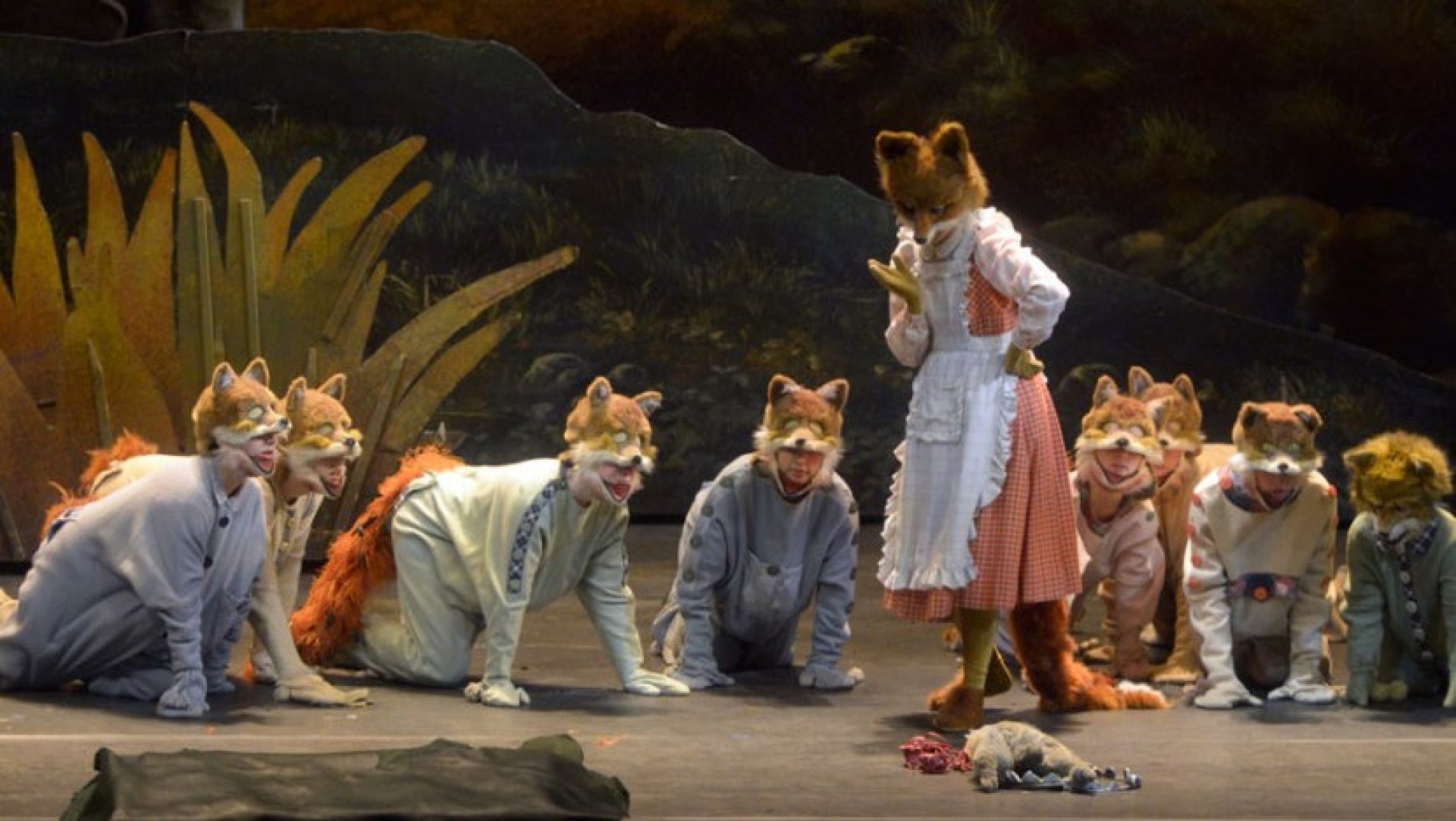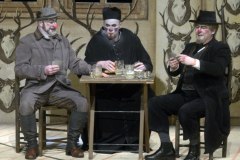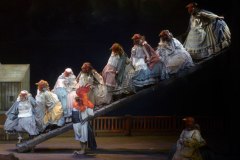The Cunning Little Vixen
Mo | Tu | We | Th | Fr | Sa | Su |
The Cunning Little Vixen - Leoš Janáček (1854 – 1928)
Opera in 3 acts
Libretto by Leoš Janáček based on a novel by Rudolf Těsnohlídek
German text by Peter Brenner based on Max Brod's translation
First performed on 6th November, 1924 in Brunn
Premiered at the Deutsche Oper Berlin on 30th June, 2000
Recommended for ages 10 and up.
Synopsis
Act 1
In the forest, the animals and insects are playing and dancing. The forester enters and lies down against a tree for a nap. A curious vixen cub (often sung by a young girl), inquisitively chases a frog right into the lap of the surprised forester who forcibly takes the vixen home as a pet. Time passes (in the form of an orchestral interlude) and we see the vixen, now grown up into a young adult (and sung by a soprano) tied up in the forester's yard with the conservative old dachshund. Fed up with life in confinement, the vixen chews through her rope, attacks the rooster and hen, kills the other chickens, jumps over the fence and runs off to freedom.
Act 2
The vixen takes over a badger's home and kicks him out. At the inn, the parson, the forester, and the schoolmaster drink and talk about their mutual infatuation with the gypsy girl Terynka. The drunken schoolmaster leaves the inn and mistakes a sunflower behind which the vixen is hiding for Terynka, professing his devotion to her. The forester, also on his way home, sees the vixen and fires two shots at her, sending her running. Later, the vixen, coming into her adulthood, meets a charming boy fox, and they retire to the badger's home. An unexpected pregnancy and a forest full of gossipy creatures necessitate their marriage, which rounds out the act.
Act 3
The poacher Harašta is engaged to Terynka and is out hunting in preparation for their marriage. He sets a fox trap, which the numerous fox and vixen cubs mock. Harašta, watching from a distance, shoots and kills the vixen, sending her children running. At Harašta's wedding, the forester sees the vixen's fur, which Harašta gave to Terynka as a wedding present, and flees to the forest to reflect. He returns to the place where he met the vixen, and sits at the tree, grieving the loss of both the vixen and Terynka. His grief grows until, just as in the beginning of the opera, a frog unexpectedly jumps in his lap, the grandson of the one who did so in Act 1. This reassurance of the cycle of death bringing new life gives his heart a deep peace.
Program and cast
Duration: 2 h 15 mins / one interval
In German with German and English surtitles
Introduction (in German language): 45 minutes before beginning; Rang-Foyer
Cast
Conductor: Marko Letonja
Stage-Production: Katharina Thalbach
Stage-design, Costume-design: Ezio Toffolutti
Chorus-master: Thomas Richter
Children's Chorus: Christian Lindhorst
Choreography: Darie Cardyn
Forester: Joel Allison, Geon Kim (22.12.2024 | 04.01.2025)
Foresters wife, Woodpecker: Stephanie Wake-Edwards
Owl: N. N.
Schoolmaster and sausage dog: Clemens Bieber
Priest and badger: Andrew Harris
Harasta: Jared Werlein
Pasek: N. N.
Cunning Little Vixen: Meechot Marrero, Alexandra Oomens (22.12.2024 | 04.01.2025)
Innkeeper: Maria Motolygina
Fox: Arianna Manganello, Martina Baroni (22.12.2024 | 04.01.2025)
Frantik, Grasshopper and Jaybird: Maria Vasilevskaya
Hen: N. N.
Pepik, Grasshopper: Lilit Davtyan
Chanticleer, Mosquito: Chance Jonas-O'Toole
Foxes: Kinderchor der Deutschen Oper Berlin
Chorus: Chor der Deutschen Oper Berlin
Orchestra: Orchester der Deutschen Oper Berlin
Dance: Opernballett der Deutschen Oper Berlin
Deutsche Oper Berlin
The Deutsche Oper Berlin is an opera company located in the Charlottenburg district of Berlin, Germany. The resident building is the country's second largest opera house and also home to the Berlin State Ballet.
The company's history goes back to the Deutsches Opernhaus built by the then independent city of Charlottenburg—the "richest town of Prussia"—according to plans designed by Heinrich Seeling from 1911. It opened on November 7, 1912 with a performance of Beethoven's Fidelio, conducted by Ignatz Waghalter. After the incorporation of Charlottenburg by the 1920 Greater Berlin Act, the name of the resident building was changed to Städtische Oper (Municipal Opera) in 1925.
Deutsches Opernhaus, 1912
With the Nazi Machtergreifung in 1933, the opera was under control of the Reich Ministry of Public Enlightenment and Propaganda. Minister Joseph Goebbels had the name changed back to Deutsches Opernhaus, competing with the Berlin State Opera in Mitte controlled by his rival, the Prussian minister-president Hermann Göring. In 1935, the building was remodeled by Paul Baumgarten and the seating reduced from 2300 to 2098. Carl Ebert, the pre-World War II general manager, chose to emigrate from Germany rather than endorse the Nazi view of music, and went on to co-found the Glyndebourne opera festival in England. He was replaced by Max von Schillings, who acceded to enact works of "unalloyed German character". Several artists, like the conductor Fritz Stiedry or the singer Alexander Kipnis followed Ebert into emigration. The opera house was destroyed by a RAF air raid on 23 November 1943. Performances continued at the Admiralspalast in Mitte until 1945. Ebert returned as general manager after the war.
After the war, the company in what was now West Berlin used the nearby building of the Theater des Westens until the opera house was rebuilt. The sober design by Fritz Bornemann was completed on 24 September 1961. The opening production was Mozart's Don Giovanni. The new building opened with the current name.

 EN
EN DE
DE IT
IT FR
FR ES
ES RU
RU JP
JP RO
RO
 Seating plan
Seating plan 



